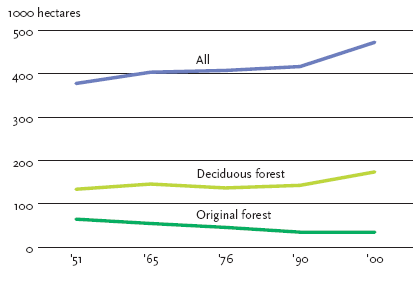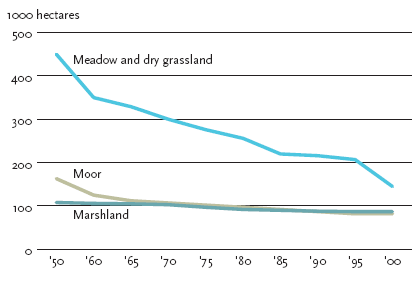|
| Front page | | Contents | | Previous | | Next |
Key indicators 2004
8
Area of natural habitats (deciduous forest, original forest)
Source: Nature and Environment – Selected Indicators 2001

This indicator illustrates developments in relation to the objective of securing a high degree of biodiversity and protecting ecosystems. Figure 8a shows developments from 1950 to 2000 as regards the area
of original forest, deciduous forest, and total forest. Figure 8b shows the development during the period 1950 to 2000 for meadows, marshes, moors and dry grasslands. The data for the indicator is not
calculated in the same way any longer, and therefore it will not possible to show more recent figures until early 2005, when new calculations will be ready.
Original forests are under pressure
From 1950 to 2000, the total forest area increased steadily, whereas the area of deciduous forest only changed relatively slightly. We also see that the area of original forest has fallen. The difference
between the total area and the deciduous area mainly comprises imported conifers (particularly common spruce). Figure 8b shows that all three of the open natural habitats dwindled in extent during the period 1950 to 2000. Indeed, the
total area of the three types of natural habitat covered only half as much land in 2000 as it did in 1950.
8a
Area of natural habitats (meadow, dry grassland, moor, and marshland)
Source: Nature and Environment – Selected Indicators 2001

One objective is to increase the extent of Danish woodland areas so that forests cover 20-25 per cent of the area of Denmark. At the same time, the aim is to increase the area of deciduous forest and retain
the area of original forest. The latest inventories show that the area of deciduous forest is once again rising. It is also aimed to increase the area accounted for by the open natural habitats: meadows, dry
grasslands, and moors. This has not, however, had a discernible impact in the most recent calculations.
| Front page | | Contents | | Previous | | Next | | Top |
Version 1.0 May 2005, © Danish Environmental Protection Agency
|